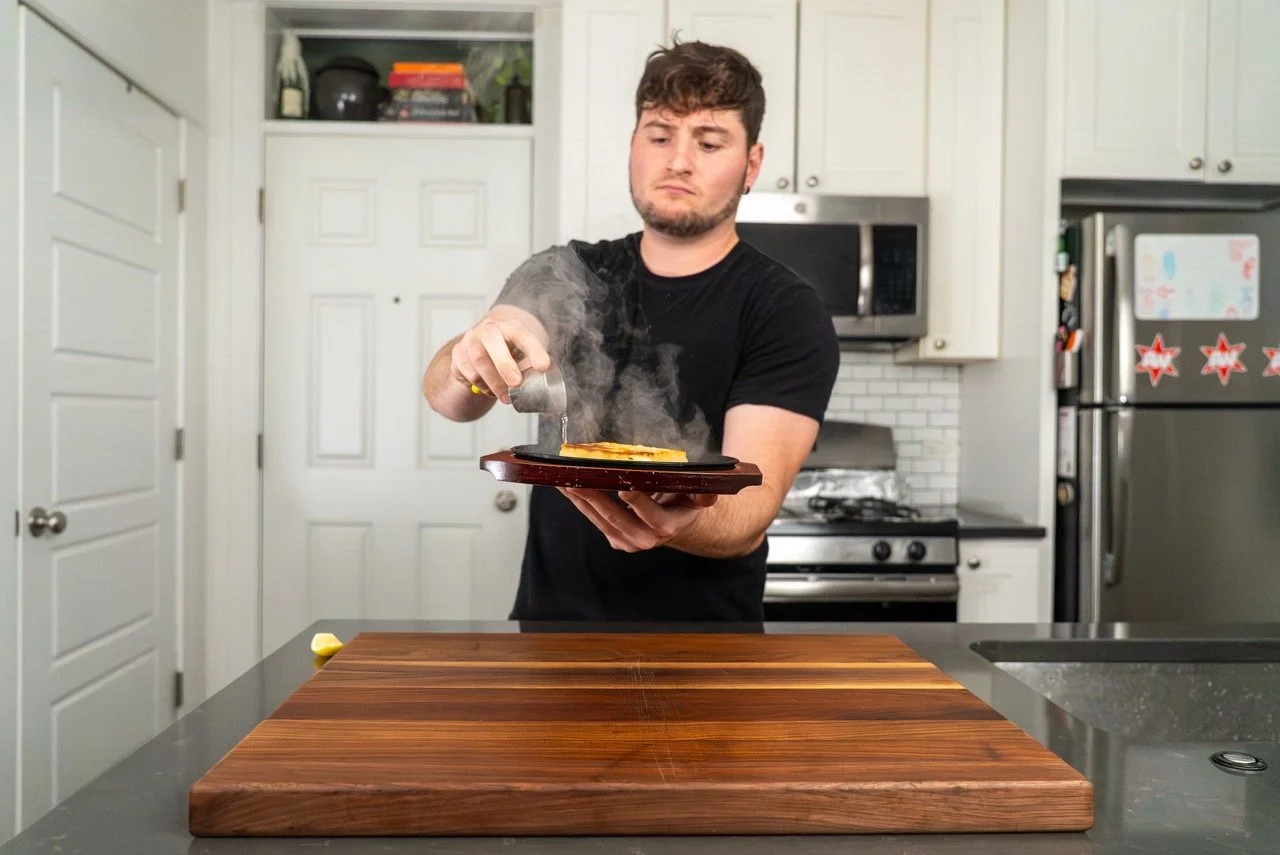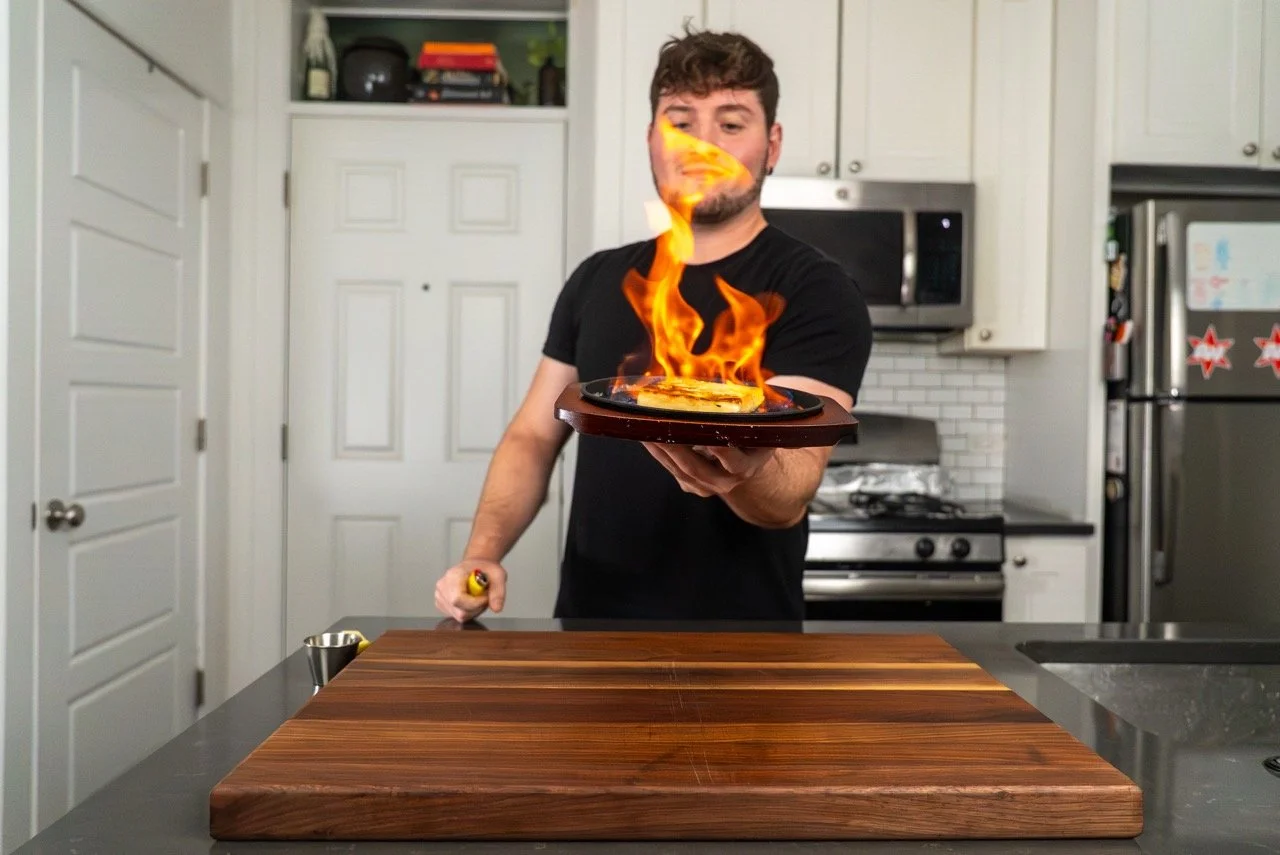Saganaki (Greek Flaming Cheese)
Saganaki is the famous Greek cheese dish that Chicago turned into a tableside spectacle. In Greece, saganaki just means “little pan” usually bubbling cheese or seafood finished with lemon, never with flames. But here in Chicago, restaurants lit it on fire, shouted “OPA!” and made it one of the city’s most unforgettable dining experiences. Who invented Saganaki? Where did it come from? And how did this humble hunk of curd change the Greek dining scene forever? We’ll talk all about it then I’ll show you how to make it like it’s done here in Chicago. εβίβα!
Some say that Saganaki the way it’s enjoyed today was invented by Petros Kogiones and his brother who first put tables outside of Diana’s Grocery in the early 1960s. This grocery would later become Diana’s Opaa (yes, there’s two “a”s and is misspelled on purpose.)
Others believe that ex-employees of Diana’s Opaa started the trend of lighting the Saganaki tableside with brandy and extinguishing the flames with lemon juice at The Parthenon off of Halsed street in the heart of Chicago’s Greektown (1968-2016).
Nobody knows for sure, but the truth could be somewhere in the middle. With Petros igniting the first flame and The Parthenon adding it’s own flair with brandy and lemon juice, but this is only speculation.
Chicago’s Greektown, centered on Halsted Street just west of the Loop, grew in the mid-20th century as Greek immigrants opened bakeries, coffeehouses, and tavernas that became the heart of the community. It was here that saganaki was famously lit aflame for the first time, creating a dining spectacle that spread worldwide. Through the 1970s and 1980s, Greektown thrived as a destination for late-night dining, plate-smashing celebrations, and iconic restaurants like The Parthenon and Dianna’s Opaa.
These days Greektown is quieter. Rising rents and shifting communities pushed a lot of the families out to the suburbs, and the legendary spots like The Parthenon and Dianna’s Opaa closed their doors. It’s not the roaring scene it once was, but the legacy is still in the DNA of Chicago food culture. Every time I hit a skillet with a squeeze of lemon I can hear the echo of those old nights, and I swear the city’s a little better for having lived them.
STUFF I USE...
Cast Iron Sizzle Plate: https://amzn.to/46GbG2a
Smoke Tube: https://amzn.to/4loXcsW
Hickory Wood Pellets: https://amzn.to/3J9fNMj
Prague Powder #1: https://amzn.to/4ozJYwo
My Cookware Set: https://amzn.to/3vaWhbG
My Dutch Oven: https://amzn.to/48MKuhq
Portable Single-burner Stove: https://amzn.to/3IytyjV
Butane Torch: https://amzn.to/48TkQra
Deli Containers: https://amzn.to/49QO635
Large Mason Jars (32oz, wide mouth): https://amzn.to/49QO635
Rust-proof Mason Jar Lids: https://amzn.to/49QWlfy
Butane Canisters: https://amzn.to/3wLUtpM
Coarse Reinforced Strainer: https://amzn.to/3PePLHK
Fine Mesh Reinforced Strainer: https://amzn.to/3TxvkYP
Sheet Trays: https://amzn.to/3IG3zXL
The BEST Smash Burger Spatula: https://amzn.to/3UdSHab
Cutting Board Scraper: https://amzn.to/3Jy64fx
Ice Cream Maker: https://amzn.to/3wd2vIu
My Induction Burner: https://amzn.to/4dfhJNE

Saganaki (Greek-American Flaming Cheese)
Ingredients
Instructions
- Brush the cheese slice with water and dredge in flour.
- Heat olive oil in a small frying pan over medium-high heat.
- As soon as the oil starts smoking, place the cheese onto the pan to quickly brown.
- Flip the cheese when the first side is brown; when the second side is brown, add brandy and quickly light.
- Shout “Opa!” and squirt lemon over the top to help extinguish the flames.
- Serve with lemon slices, olive oil and crusty bread.
Adam's Notes
- Kayseri, Kefalograviera, Graveira are the preferred Greek cheeses for Saganaki. In a pinch, you can totally use Halloumi, though it is a slightly different experience.
Disclaimer: I earn commission income with qualifying purchases made through Amazon’s Affiliate program and other affiliate links in this description.












